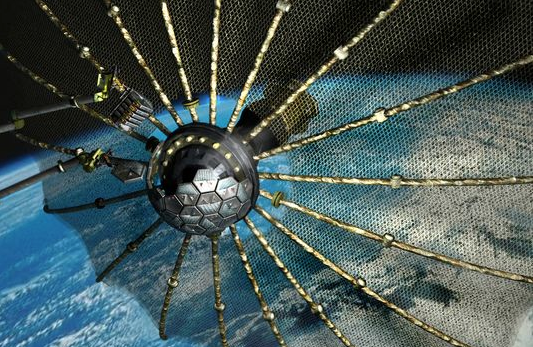[SatNews] "With over 1,300 satellites launched to GEO since the 1960's, it estimated over $300 billion worth of hardware and approximately 20,000 kg of apertures are in the GEO belt today."
Talbot Jaeger and NovaWurks, are ready to begin the Pentagon's plan to recycle dead satellites. Jaeger, the founder and chief technologist of NovaWurks, a Los Alamitos, California-based company, has a mission to loosen the government ties on space exploration. "The perception of the industry is that it's stodgy and bureaucratic," he said. "We're going at the entire process to reduce the costs and time to orbit."
At the heart of NovaWurks' business is the "conformal spacecraft," which the company calls a "flexible, modular solution able to 'conform' to the shape and capability requirements of any payload."

A DARPA drawing of a potential Phoenix satellite.(Photo: HOPD, AP)
The Defense Advanced Research Projects Agency (DARPA) issued its first call for research into its Phoenix program in December 2011. At the time, DARPA records show, it sought to "develop and demonstrate technologies to cooperatively harvest and reuse valuable components from retired, non-operating satellites in geosynchronous orbit (GEO) and demonstrate the ability to create new space systemThe Pentagon's Defense Advanced Research Projects Agency (DARPA) and its Project Phoenix's goal is to recycle the billions of dollars worth of dead satellites floating around the Earth in geosynchronous orbit, 22,000 miles above the planet. NovaWurks has the first and largest DARPA contract for the program, which hopes to have an "on-orbit" demonstration next year or in 2016.
Phoenix envisions attaching some of the replacement "satlets" to existing commercial payloads that are routinely sent into orbit. Once in space, those satlets would then break off and link up to old satellites orbiting the Earth.
"Retired GEO satellites have already incurred the highest costs in a space system mission life cycle: fabrication, launch, and deployment," a DARPA planning document shows. "With over 1,300 satellites launched to GEO since the 1960's, it estimated over $300 billion worth of hardware and approximately 20,000 kg of apertures are in the GEO belt today."
Phoenix is not the only program developed by DARPA aimed at saving money on ISR. Among other projects, it is researching how to use drones that operate without human pilots and a submarine that can release underwater and aerial drones.lop its conformal spacecraft for DARPA in the hopes the craft can be sent into orbit with another payload and then be directed to one of the many dead and abandoned satellites, where it will be attached and used to revive the old satel
NovaWurks' Hyper Integrated Satlet (HISat) will then use the old satellite's large reflector antennas to communicate and start a new mission.
"There are number of reasons why a satellite's life will end," Jaeger said. "It will run out of propellant. The motors that make it work can run out, or the electronics on board will suffer from radiation and stop working. They all have specific lifetimes, and they all have components that can break."
The beauty of the large reflectors, which can be up to 45 feet wide, is that "they have no moving parts," Jaeger said. "They're not limited by propellants."
Phoenix is part of what Jaeger calls a "paradigm shift" in space exploration, as the government and private industry move from overly bureaucratic programs to cheaper, more nimble ones. That's certainly a priority for the Pentagon, which has issued calls to industry for cheaper ways to run unmanned drones and satellites that provide what the military calls intelligence, surveillance and reconnaissance.
"It's a different paradigm," Jaeger said. "There are people in this field who believe in that shift and do not want to make this into a government-owned and locked market. That's how we got into it. (Phoenix) fits perfectly into what we've been doing."

